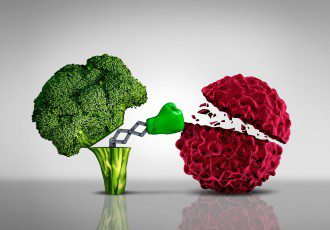Guest writer for Wake Up World
Is it possible that chromosomal damage is simply a marker for cancer and not the actual cause of the disease? Compelling evidence suggests this is the case, and in the featured lecture, orthopedic surgeon Dr. Gary Fettke reviews some of this evidence.
Having battled cancer himself, Fettke came to realize the influence of nutrition on cancer, and the importance of eating a diet high in healthy fats and low in net carbohydrates (total carbs minus fiber, i.e. non-fiber carbs). Fettke is not the only one promoting the metabolic model of cancer.
Earlier this year I interviewed Travis Christofferson, author of a phenomenal book on this topic, called “Tripping Over the Truth: The Return of the Metabolic Theory of Cancer Illuminates a New and Hopeful Path to a Cure“.
[pro_ad_display_adzone id=”110028″]
The Metabolic Model of Cancer
The Cancer Genome Atlas project that began in 2006 set out to sequence the genomes of cancer cells. It was the largest government project ever conceived, involving 10,000 times the amount of genetic sequencing done by the Human Genome Project. Alas, the results didn’t conform to their original expectations.
The evidence clearly showed that something other than mere gene mutation was at play. The mutations found in cancer cells were simply too random. Some cancers didn’t even have any genetic mutations driving them. So what then could the driving factor be?
In a nutshell, the nuclear genetic defects typically thought to be responsible for cancer actually occur further downstream. Mitochondrial damage happens first, which then triggers nuclear genetic mutations that may lead to cancer.
Moreover, scientists are now finding that mitochondrial dysfunction is at the core of virtually ALL diseases, placing mitochondrial function at the very center of just about any wellness or disease prevention program.
As Fettke notes, one of the primary considerations is glucose metabolism within your mitochondria — a theory initially brought forth by Dr. Otto Warburg in the 1920s.
In 1931, Warburg won the Nobel Prize in Physiology or Medicine for his discovery that cancer cells have a fundamentally different energy metabolism compared to healthy cells. As it turns out, cancer cells do not have the same metabolic flexibility as healthy ones.
Dr. Gary Fettke: ‘Nutrition and Cancer — Time to Rethink’
Cancer Cells Are Metabolically Limited to Feed on Sugar
A cell can produce energy either aerobically, in the mitochondria, or anaerobically, in the cytoplasm. Anaerobic metabolism generates excessive levels of lactic acid, which can be toxic.
Warburg discovered that in the presence of oxygen, cancer cells overproduce lactic acid, and this became known as the Warburg Effect. So what does this tell us about the nutritional origins of cancer? In a nutshell, Warburg’s findings tell us that sugar “feeds” cancer while fats “starve” it.
Healthy cells can use either glucose or ketone bodies from fat as an energy source, but cancer is metabolically restricted to using glucose only. Cancer cells for the most part lack metabolic flexibility and simply cannot metabolize ketones, and this is why nutritional ketosis appears to be so effective against cancer.
Cancer could actually be more accurately classified as a mitochondrial metabolic disease. Few people inherit genes that predispose them to cancer. Most inherit genes that prevent cancer. Inherited mutations typically disrupt the function of the mitochondria, and the heightened risk for cancer is a result of that weakness.
The good news is you can optimize your mitochondrial function by addressing certain lifestyle factors such as diet and exercise, and this knowledge opens up a whole new way of looking at and treating cancer.
As explained by Fettke, the metabolic model of cancer is “based around energy and growth; random chromosomal mutations are secondary.” Furthermore:
“All cells require an energy source of adenosine triphosphate (ATP). They also require building materials that are either sourced locally or transported in normal cells convert glucose primarily into ATP and a little into maintenance.
Cancer cells do the opposite. There’s a diversion of glucose away from ATP production to the building materials required for cell growth … The other building materials require protein and fatty acids and cancer steals those from its surroundings.
That invasion of surrounding tissue accounts for how cancer spreads and metastasizes … The driving force behind all of this is oxygen-free radical production.
I believe the free radical production then causes the DNA damage in a random fashion, and account for the chromosomal abnormalities. So, if we can find the source of the oxygen free radicals, we might be onto something.”
Processed Food Diet Is a Major Cancer Promoter
What drives free radical production? Inflammation is a major driver, and our modern processed food diet is highly inflammatory.
Key culprits include polyunsaturated fats (PUFAs), trans fats and added sugar in all its forms, especially processed fructose (such as high-fructose corn syrup), as well as refined grains. Artificial ingredients can also promote inflammation.
By reducing the amount of net carbs you eat, you will accomplish four things that will result in lowered inflammation and reduced stimulation of cancer growth. You will:
- Lower your serum glucose level
- Reduce your mTOR level
- Reduce your insulin level
- Lower insulin growth factor-1 (IGF-1, a potent hormone that acts on your pituitary gland to induce metabolic and endocrine effects, including cell growth and replication. Elevated IGF-1 levels are associated with breast and other cancers)
Indeed, one of the basic reasons why a high-fat, low-net carb diet (nutritional ketosis) works so well is because it drives your inflammation down to almost nothing. And when inflammation disappears, your body can heal.
[pro_ad_display_adzone id=”110028″]
What Cancer Requires for Growth
In order to thrive and grow, cancer cells need fuel in the form of glucose, plus building materials in the form of protein, fatty acids, phosphate and acetate. These building materials are not readily available in your bloodstream, so cancer cells “steal” them from surrounding cells.
The process that allows the cancer cells to invade surrounding tissue is known as the Reverse Warburg Effect. This effect is based on hydrogen peroxide generation caused by the interaction between oxygen free radicals and water.
So invasive or metastasizing cancer, in essence, is the result of the Warburg Effect and the Reverse Warburg Effect. I highly recommend viewing the featured video to get a better grasp on these processes, and how they contribute to cancer formation and spread. As noted by Fettke, knowing all of this presents us with a whole new set of cancer prevention and treatment options, including the following:
- Limit or eliminate sugar and net carbohydrates (non-fiber carbs) to avoid feeding cancer cells
- Limit or eliminate PUFA oils and trans fats to prevent the formation of harmful free radicals and damaging small, dense LDL particles
- Limit protein (I recommend using a formula of one-half gram of protein per pound of lean body mass) to avoid stimulating mTOR pathway
- Increase antioxidant intake (via whole food and/or supplements) to counteract free radical damage
- Increase healthy fat intake to feed healthy cells while starving cancer cells
The Importance of Diet for Successful Cancer Treatment
Remember, the foundational aspect that must be addressed is the metabolic mitochondrial defect, and this involves radically reducing the non-fiber carbohydrates in your diet and increasing high-quality fats. This does not mean a low total carbohydrate diet. You need to have plenty of fresh, organic and fiber-filled vegetables (low net carbs).
You can actually have several hundred grams of vegetables per day as the fibers will be converted to short-chain fatty acids, which will improve your ability to burn fat for fuel and also nourish your microbiome.
You can replace the non-fiber carbs with up to 70 to 85 percent healthy fats, along with a moderate amount of high-quality protein, as excessive protein can also trigger cancer growth by stimulating mTOR, which accelerates cancer growth. That’s really the solution. If you don’t do that, other treatments may not work.
According to Fettke, studies have shown that nutritional ketosis, i.e. eating a high-fat, low-net carb diet significantly improves health outcomes in patients undergoing conventional cancer treatment such as chemotherapy.
 It’s also important to remember that glucose is an inherently “dirty” fuel as it generates far more reactive oxygen species and secondary free radicals than burning fat. But to burn fat, your cells must be healthy and normal. Cancer cells lack the metabolic flexibility to burn fat and this why a healthy high-fat diet appears to be such an effective anti-cancer strategy.
It’s also important to remember that glucose is an inherently “dirty” fuel as it generates far more reactive oxygen species and secondary free radicals than burning fat. But to burn fat, your cells must be healthy and normal. Cancer cells lack the metabolic flexibility to burn fat and this why a healthy high-fat diet appears to be such an effective anti-cancer strategy.
When you switch from burning glucose as your primary fuel to burning fat for fuel, cancer cells really have to struggle to stay alive, as most of their mitochondria are dysfunctional and can’t use oxygen effectively to burn fuel. At the same time, healthy cells are given an ideal and preferred fuel, which lowers oxidative damage and optimizes mitochondrial function. The sum effect is that healthy cells begin to thrive while cancer cells are starved.
General Nutrient Ratio Guidelines for Mitochondrial Health and Cancer Prevention
For optimal health, you need sufficient amounts of carbohydrates, fats, and protein. However, ever since the advent of processed foods and industrial farming, it’s become increasingly important to be specific when discussing these nutrients. There are healthy fats and unhealthy ones. Ditto for carbohydrates and protein. Much of the benefits or risks are related to how the food was grown, raised, and/or processed.
To achieve nutritional ketosis, it is important to keep track of your net carbs and total protein intake. Net carbs are calculated by taking the total number of carbohydrates in grams and subtracting the amount of fiber contained in the food. The resulting number is your net carbs. For optimal health and disease prevention, I recommend keeping your net carbs below 40 or 50 grams per day.
Translating Ideal Protein Requirements Into Foods
Substantial amounts of protein can be found in meat, fish, eggs, dairy products, legumes, nuts, and seeds. Some vegetables also contain generous amounts of protein — for example, broccoli. To determine whether or not you’re getting too much protein, simply calculate your body’s requirement based on your lean body mass by subtracting your percentage of body fat from 100, and write down everything you eat for a few days.
Then, calculate the amount of daily protein you’ve consumed from all sources. Again, you’re aiming for one-half gram of protein per pound of lean body mass. If you’re currently averaging a lot more than what is optimal, adjust downward accordingly. You could use the chart below or simply Google the food you want to know and you will quickly find the grams of protein in that food.
| Red meat, pork, poultry, and seafood average 6 to 9 grams of protein per ounce.
An ideal amount for most people would be a 3-ounce serving of meat or seafood (not 9- or 12-ounce steaks!), which will provide about 18 to 27 grams of protein |
Eggs contain about 6 to 8 grams of protein per egg. So an omelet made from two eggs would give you about 12 to 16 grams of protein
If you add cheese, you need to calculate that protein in as well (check the label of your cheese) |
| Seeds and nuts contain on average 4 to 8 grams of protein per quarter cup | Cooked beans average about 7 to 8 grams per half cup |
| Cooked grains average 5 to 7 grams per cup | Most vegetables contain about 1 to 2 grams of protein per ounce |
Beware of Unhealthy Fats
When it comes to fat, it’s really crucial to distinguish healthy from the unhealthy ones. The vast majority of fats people eat are actually very unhealthy. As a general rule, avoid all processed and bottled vegetable oils, which are typically high in damaged omega-6 fats. (Also be careful with olive oil. While healthy, up to 80 percent of commercial olive oils are actually adulterated with oxidized omega-6 vegetable oils, so make sure it’s third party-certified as genuine.)
Another general rule: do not be afraid of naturally saturated fats! They’re among the healthy ones. Sources of healthy fats you want to include more of in your diet include:
| Olives and olive oil (third party-certified authentic) | Coconuts and coconut oil | Butter made from raw grass-fed organic milk, and cacao butter |
| Raw nuts, such as, macadamia and pecans, and seeds like black sesame, cumin, pumpkin, and hemp seeds | Organic-pastured egg yolks | Avocados |
| Grass-fed meats | Lard, tallow and ghee | Animal-based omega-3 fat such as krill oil |
Nutritional Ketosis Can Offer Hope and Health
Fettke finishes his lecture listing a number of known benefits of nutritional ketosis in the treatment of cancer, including the following:
| It’s safe | It’s well-tolerated |
| It can be used with other cancer treatments (and may actually improve the effectiveness of conventional cancer treatments) | Ketones are protective to surrounding cells, reducing the power of the cancer to spread |
| It gives patients a sense of control, which has been shown to improve survival rates | If useful as a treatment, it should certainly be considered for prevention |
| It gives patients hope, which also improves survival | It’s the least expensive cancer treatment available |
A Radical Experiment in Nutritional Ketosis
To give you an idea of how nutritional ketosis can benefit your health beyond cancer prevention, consider the case of Dr. Peter Attia. His experiment is a very clear example of the effects diet can have on overall health markers. Attia is a Stanford University-trained physician with a passion for metabolic science, who decided to use himself as a lab rat — with incredible results. He describes his experiment in the video below.
Although he’s always been active and fit, he did not have genetics on his side. His natural tendency was toward metabolic syndrome, in spite of being very diligent about his diet and exercise. So he decided to experiment with nutritional ketosis to see if he could improve his overall health status.
For a period of 10 years, he consumed 80 percent of his calories from healthy fat and continuously monitored his metabolic markers, such as blood sugar levels, body fat percentage, blood pressure, lipid levels and others.
He experienced improvement in every measure of health, as you can see in the table below. An MRI confirmed that he had lost not only subcutaneous fat but also visceral fat, which is the most detrimental type. His experiment demonstrates how diet can produce major changes in your body, even if you are starting out relatively fit. And if you’re starting out with a low level of fitness, then the changes you experience may be even more pronounced.
| BEFORE | AFTER | |
|---|---|---|
| Fasting blood sugar | 100 | 75 to 95 |
| Percentage body fat | 25 | 10 |
| Waist circumference in inches | 40 | 31 |
| Blood pressure | 130/85 | 110/70 |
| LDL | 113 | 88 |
| HDL | 31 | 67 |
| Triglycerides | 152 | 22 |
| Insulin sensitivity | Baseline | Increased by more than 400 percent |
About the author:
 Born and raised in the inner city of Chicago, IL, Dr. Joseph Mercola is an osteopathic physician trained in both traditional and natural medicine. Board-certified in family medicine, Dr. Mercola served as the chairman of the family medicine department at St. Alexius Medical Center for five years, and in 2012 was granted fellowship status by the American College of Nutrition (ACN).
Born and raised in the inner city of Chicago, IL, Dr. Joseph Mercola is an osteopathic physician trained in both traditional and natural medicine. Board-certified in family medicine, Dr. Mercola served as the chairman of the family medicine department at St. Alexius Medical Center for five years, and in 2012 was granted fellowship status by the American College of Nutrition (ACN).
While in practice in the late 80s, Dr. Mercola realized the drugs he was prescribing to chronically ill patients were not working. By the early 90s, he began exploring the world of natural medicine, and soon changed the way he practiced medicine.
In 1997 Dr. Mercola founded www.Mercola.com, which is now routinely among the top 10 health sites on the internet. His passion is to transform the traditional medical paradigm in the United States. “The existing medical establishment is responsible for killing and permanently injuring millions of Americans… You want practical health solutions without the hype, and that’s what I offer.”
Visit www.Mercola.com for more information, or read Dr. Mercola’s full bio and résumé here.
Recommended articles by Dr Mercola:
- How the War on Drugs Has Caused More Harm Than Good
- Vaccine Failures Continue – The One Size Fits All Vaccination Schedule is Not Safe for Every Child
- 7 Domestic Factors That Can Make or Break Your Health
- Scientific Review Shows Fluoridation Does Not Prevent Cavities
- Scientific Links Between Processed Foods and Depression
- The Surprising Ways in Which Fast Food and its Packaging Harms Your Health
- How Sugar Harms Your Brain Health and Drives Alzheimer’s Epidemic
- The Health Benefits of Intermittent Fasting
- Can a Hug a Day Keep Infection Away?
- The Fluoride Deception Continues as US Government Ignores Fluoride’s Role as an Endocrine Disruptor
- Magnesium: An Invisible Deficiency That Could Be Harming Your Health
[pro_ad_display_adzone id=”110027″]







